techcrunch
#HTE
It’s the golden age of design for software companies. Designers are becoming more visible and popular on engineering teams, figuring out everything from the visuals of color palette and fonts to the deeper interaction flows and user experience journeys that underlie products. As my colleague Jordan Crook recently described, that popularity has translated into one of the big venture gold rushes to serve this newly-empowered enterprise customer.
Yet, between the Figmas and the Canvas and the InVisions and the Adobes lies a very specific challenge for designers: finding a way to translate prototypes from their heads into usable products for engineers to build on. Most of the design tools on the market help designers build their own prototypes independently, or collaborate with other designers. Worse, they often are unable to handle the complexity of modern digital products, which can end up on a range of end devices.
That’s where ProtoPie comes in. The service empowers designers to create high-fidelity prototypes of products, including products that might end up in such places as digital display kiosks, automobile dashboard screens, mobile phones, and others. The tool can also adapt prototypes based on readings from sensors like motion detection. Those prototypes, once accepted, can then be easily handed off to engineering teams for implementation.
In short, it’s “prototyping as easy as pie.”
The Seoul, South Korea-based company was founded by Tony Kim, a former designer at Google, along with two lead engineers at Samsung and Line. Kim left in December 2014 after getting fed up with existing design tools on the market and the lack of a clear winner in the interaction prototyping space.
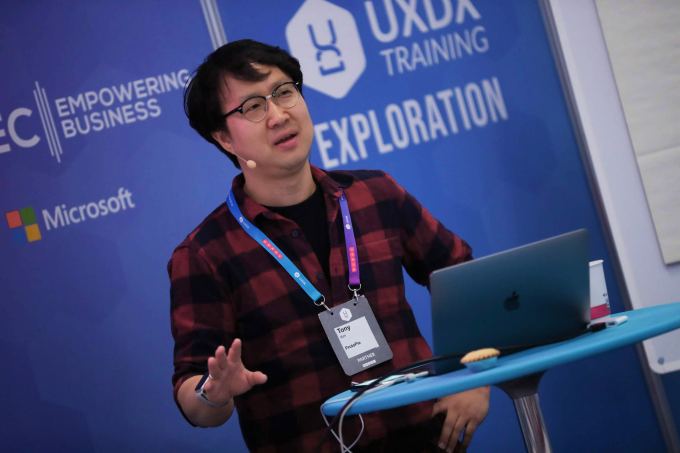
ProtoPie founder Tony Kim (Photo via ProtoPie).
Over the past few years, he and his team have been building out the full feature set and growing the company within the design community following the product’s first launch in January 2017. Now, the company is charting a vastly growing curve following a switch to enterprise licensing last year, announcing today a $6.3 million expansion of its series A round led by Vela Partners. The company has collected a total of $9.9 million in venture capital since its founding.
Jenna Yim, who is chief strategy officer, offered an example of a car manufacturer prototyping a product. Most existing software tools focus on validating user flow, so you “click, click, click, and see how the screens transition,” she explained. But what happens if those screens should change depending on whether the user is in the driver’s seat or passenger seat, or whether the car is traveling at high-speed and safety is a concern? ProtoPie is “a lot more expressive than other tools you might see,” she said. “Because of our concept model, we can also create the interaction between multiple device interactions without any code.”
The company says that it has 100,000 global paid users, with major deals with Microsoft, Google, and other prominent tech companies. CEO Kim says that “even though we are based in Seoul, South Korea, most of our revenues come from outside of Korea … the US market is one of the big parts, followed by Japan, Germany, and China.”
With the new funding, the company intends to expand its sales team in North America and potentially launching a more expansive headquarters there as well. Kim says he also wants to expand the product’s collaboration features like its content library, so that users can pull pre-made components from other designers online.
The startup currently has 33 people mostly based out of its office in Gangnam, Seoul, and has a “everyone can work from everywhere” culture.
https://techcrunch.com/2020/02/24/protopie-helps-designers-translate-their-work-to-engineering-without-the-hassles/
#HTE
Sony has announced its first 5G smartphone: The Xperia 1 II — which, for the curious and/or confused, is pronounced ‘Xperia One, Mark Two’. Which isn’t at all confusing, er.
“No one understands the entertainment experience better than Sony,” said president of mobile communications, Mitsuya Kishida, claiming the company is “uniquely positioned” in the era of 5G cellular technology to offer its target users an “enriched” experience thanks to Sony’s extensive content portfolio.
“Whether you are a broadcast professional who requires dynamic speed or an everyday user who desires enhanced entertainment Xperia with 5G takes your mobile experience to the next level,” he said.
As ever with Sony — a major b2b supplier of image sensors to other smartphone makers (rather than a major seller of its own phones) — it’s made the camera a huge focus for the new Android 10 flagship, which has a 6.5in 21:9 “CinemaWide” 4K HDR OLED (3840×1644) display and is powered by a Qualcomm 865 Snapdragon chip (with 8GB of RAM on board).
Round the back the Xperia 1II packs three lenses which offer a selection of focal lengths (16mm, 24mm and 70mm) for capturing different types of photos — from super wide angle to portraits.
All three rear lenses have a 12MP sensor, while round the front there’s an 8MP lens. Sony is also using Zeiss optics for the first time in a smartphone, expanding a long-running collaboration to a new device type.
Talking up the camera, Kishida touted ultrafast low light autofocus, noting too that it supports 20fps autofocus and auto-tracking burst (which he called a world first in a smartphone) — for capturing crisp action shots.
“Our new continuous auto focus keeps tracking moving subjects. What’s special about this is with 20fps it calculates the object 3x per frame — that’s 60x per second — capturing the very moment,” he said.
“With the power and speed of 5G you will be able to share those moments more quickly and more easily across the network,” he added.
Another photo-friendly feature is real-time eye auto focus. Sony demoed this by showing it working on a video of a cat playing with a toy. So, tl;dr, Sony has trained its model on data-sets of pets too, not just humans.
A ‘Photo Pro’ interface on the handset, meanwhile, has been designed to be familiar to users of Sony’s mirrorless Alpha cameras — letting photographers tune shots via access to tweakable parameters they’re used to using on Sony’s high end digital cameras.
Sony is paying the same mind to video makers, with a video editing interface on the device that offers features such as touch autofocus and custom white balance — which Kishida said will help “visual storytellers” control the camera more easily.
There’s also a noise reduction feature to improve audio capture.
Best of all, the Xperia 1II has a 3.5mm headphone jack — enabling audiophiles to enjoy the simple pleasure of plugging in their favorite pair of high-end wired headphones and tuning out everything else.
Kishida flagged the use of an AI technology, called DSEE Ultimate, which he said upscales the sound signal to “near high resolution audio” — including when streaming. “This the best on the go acoustic experience available,” he claimed.
On the games front he touted a collaboration that will let users of the device play a mobile optimized version of Call of Duty using Play Station 4’s Dualshock 4 wireless controller.
The handset, meanwhile, packs a 4,000mAh battery as well as fast wireless charging.
Per Kishida the handset will start shipping from Spring onwards, though it’s not yet clear which markets Sony will be bringing the Xperia 1II to.
The Xperia 1II may have a fairly niche target buyer, as Sony is a relative bit player in consumer smartphone sales vs giants like Samsung and Huawei, but is intended to act as a showcase for what the company’s camera technologies can offer other mobile makers.
Sony’s mobile chief was making the announcements at a virtual press conference screened via YouTube after the company became one of the first big companies to pull out of attending the Mobile World Congress tradeshow.
MWC’s organizer, the GSMA, subsequently cancelled the annual mobile industry event, which had been due to take place in Barcelona this week, after scores of exhibitors said they would not attend — citing public health concerns attached to the novel coronavirus.
MWC typically attracts more than 100,000 visitors across four days. So the sight of Sony’s press conference being streamed to an empty room — entirely devoid of cameras, claps or woos but still with built in pauses for the media to take photos of the new hardware — was more than a little surreal.
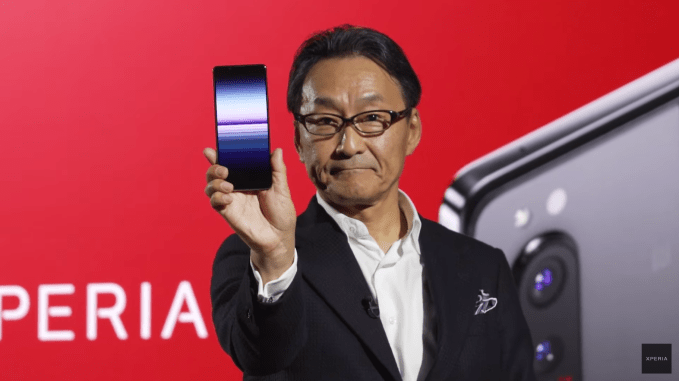
Kishida had another 5G handsets to tease: aka the Xperia Pro — a flagship handset aimed at video professional. It features 5G mm wavelength technology for improved capability to stream high-resolution video, as well as a handy micro HDMI port for easy plugging in of other high end camera kit.
Sony touted tests it’s done with US carrier Verizon (aka TechCrunch’s parent company) to use the 5G handset for live streaming live sports events.

“Sony’s expertise and long history in providing profession digital imaging solutions is very unique,” claimed Kishida. “Only Sony has such deep and well established relationships and we are bringing decades of experience to an end-to-end solution — from professional content creation to mobile communications technology in 5G.”
There was a mid range smartphone announcement too, also shipping from Spring onwards: The Xperia 10 II packs a 6in display and also features a triple lens camera as well as water resistance.
https://techcrunch.com/2020/02/24/sony-announces-its-first-5g-flagship-the-triple-lens-xperia-1-ii/
#HTE
As Indian startups begin to make inroads in the world of SaaS, Microsoft has taken notice. The American tech giant today launched 100X100X100, a program aimed at business-to-business SaaS startups.
Microsoft said Monday that 100X100X100 will bring together 100 companies and 100 early and growth startups. Each committed company will spend $100,000 over a course of 18 months.
“This initiative will help build scale and create amazing opportunities for startups. Businesses can now fast-track their digital journeys through easy adoption of enterprise-grade solutions,” said Anant Maheshwari, President of Microsoft India, in a statement.
Each startup participating in the program will also have access to prospective customers at Microsoft industry and customer events. Participants also get access to Microsoft’s technology platform, and guidance in fine tuning their business and expansion models.
Microsoft is not a new face in India’s startup ecosystem. The company runs Microsoft for Startups that allows early stage B2B startups to use the company’s Azure marketplace and enterprise sales team. Early last year, the company also expanded M12, its corporate venture fund, to India.
The company’s global rivals Google and Amazon are also actively helping startups in India, sponsoring countless events and bandying out a range of goodies including thousands of dollars of credit to use their cloud platforms.
The idea is simple: If the bets work, these startups are already a customer and their solutions could be beneficial to several tens of thousands of other customers. And it’s a safe time to make these bets.
In recent years, scores of startups have emerged in India to build SaaS software following the success of firms such as Freshworks, valued at $3.5 billion, and CleverTap. Since SaaS startups are not building hardware, or disbursing loans, they often have the best profit margin.
Shekhar Kirani, a partner at Accel, told TechCrunch in a recent interview that his biggest frustration was not seeing many more entrepreneurs build SaaS services. “Anyone with some coding skills and a cheap laptop can build a service and sell to the world,” he said.
At a recent SaaS focused event, Godard Abel, chief executive of business marketplace G2, said that India was already among the top five nations for active participations for development of new business services.
As for Microsoft, expect several more announcements this week as its chief executive, Satya Nadella, appears at company’s flagship conference in the country today and tomorrow.
https://techcrunch.com/2020/02/23/microsoft-100x100x100-b2b-saas-india-startups/
#HTE
Laiye, a Chinese startup that offers robotic process automation services to several major tech firms in the nation and government agencies, has raised $42 million in a new funding round as it looks to scale its business.
The new financing round, Series C, was co-led by Lightspeed Venture Partners and Lightspeed China Partners. Cathay Innovation, which led the startup’s Series B+ round and Wu Capital, which led the Series B round, also participated in the new round.
China has been the hub for some of the cheapest labor in the world. But in recent years, a number of companies and government agencies have started to improve their efficiency with the help of technology.
That’s where Laiye comes into play. Robotic process automation (RPA) allows software to mimic several human behaviors such as keyboard strokes and mouse clicks.
“For instance, a number of banks did not previously offer APIs, so humans had to sign in and fetch the data and then feed it into some other software. Processes like these could be automated by our platform,” said Arvid Wang, co-founder and co-chief executive of Laiye, in an interview with TechCrunch.
The four-and-a-half-year-old startup, which has raised more than $100 million to date, will use the fresh capital to hire talent from across the globe and expand its services. “We believe robotic process automation will achieve its full potential when it combines AI and the best human talent,” he said.
Laiye’s announcement today comes as the market for robotic automation process is still in nascent stage in China. There are a handful of startups looking into this space, but Laiye, which counts Microsoft as an investor, and Sequoia-backed UiPath are the two clear leaders in the market currently.
As my colleague Rita Liao wrote last year, it was only recently that some entrepreneurs and investors in China started to shift their attention from consumer-facing products to business applications.
Globally, RPA has emerged as the fastest growing market in enterprise space. A Gartner report found last year that RPA market grew over 63% in 2018. Recent surveys have shown that most enterprises in China today are also showing interest in enhancing their RPA projects and AI capabilities.
Laiye today has more than 200 partners and more than 200,000 developers have registered to use its multilingual UiBot RPA platform. UiBot enables integration with Laiye’s native and third-party AI capabilities such as natural language processing, optical character recognition, computer vision, chatbot and machine learning.
“We are very bullish on China, and the opportunities there are massive,” said Lightspeed partner Amy Wu in an interview. “Laiye is doing phenomenally there, and with this new fundraise, they can look to expand globally,” she said.
https://techcrunch.com/2020/02/23/lightspeed-leads-laiyes-42m-round-to-bet-on-chinese-enterprise-it/
#HTE
BharatPe, a New Delhi-based startup that is enabling hundreds of thousands of merchants to accept digital payments for the first time and also providing them with access to working capital, has raised $75 million in a new financing round as it looks to scale its business in the nation.
The Series C round for the one-and-a-half-year old startup was led by New York-headquartered hedge fund Coatue Management and existing investor Palo Alto-based fintech investor Ribbit Capital .
VC firm Amplo, and existing investors Steadview Capital and Insight Partners also participated in the round, which valued the startup at over $400 million. BharatPe has raised $140 million to date.
BharatPe operates an eponymous service to help offline merchants accept digital payments. Even as India has already emerged as the second largest internet market, with more than 500 million users, much of the country remains offline. Among those outside of the reach of the internet are merchants running small businesses, such as roadside tea stalls.
To make these merchants comfortable with accepting digital payments, BharatPe relies on QR codes that support government-backed UPI payments infrastructure. Ashneer Grover, co-founder and chief executive of BharatPe, said the startup will use much of the fresh capital to fund working capital for its merchant partners.
BharatPe, he said, has disbursed about $14 million “short-term” loans to over 20,000 merchants in the last seven months. New merchants can secure about $500 for a period of three months from BharatPe. As merchants spend more time on BharatPe, the firm increases the amount to about $2,000.
The startup has amassed over 3 million merchants in 30 Indian cities. It aims to more than double that number by March 2021.
The lending business is crucial to BharatPe. Payment apps make little to no money through making transactions on their platforms. Those processing UPI payments can not even charge a small commission to merchants. Additionally, access to working capital is a major challenge in developed markets such as India. According to a World Bank report, more than 2 billion people globally do not have access to working capital.
Scores of new and established players today are offering a range of solutions including lending to merchants. Earlier this month, Paytm, the largest fintech startup in India and which raised $1 billion late last year, introduced a stand that displays QR check-out codes that has a built-in calculator, and a USB charger with sound box that delivers confirmation message when a transaction has processed. The startup also unveiled a point-of-sale machine with built-in scanner and printer for merchants.
https://techcrunch.com/2020/02/23/bharatpe-raises-75m-to-help-indian-merchants-accept-digital-payments-and-secure-working-capital/
#HTE
Hello and welcome back to TechCrunch’s China Roundup, a digest of recent events shaping the Chinese tech landscape and what they mean to people in the rest of the world. The coronavirus outbreak is posing a devastating impact on people’s life and the economy in China, but there’s a silver lining that the epidemic might have benefited a few players in the technology industry as the population remains indoors.
The SARS (severe acute respiratory syndrome) virus that infected thousands and killed hundreds in China back in 2002 is widely seen as a catalyst for the country’s fledgling e-commerce industry. People staying indoors to avoid contracting the deadly virus flocked to shop online. Alibaba’s Taobao, an eBay-like digital marketplace, notably launched at the height of the SARS outbreak.
“Although it sickened thousands and killed almost eight hundred people, the outbreak had a curiously beneficial impact on the Chinese internet sector, including Alibaba,” wrote China internet expert Duncan Clark in his biography of Alibaba founder Jack Ma.
Nearly two decades later, as the coronavirus outbreak sends dozens of Chinese cities into various kinds of lockdown, tech giants are again responding to fill consumers’ needs amid the crisis. Others are providing digital tools to help citizens and the government battle the disease.
According to data from analytics company QuestMobile, Chinese people’s average time spent on the mobile internet climbed from 6.1 hours a day in January, to 6.8 hours a day during Chinese New Year, to an astounding daily usage of 7.3 hours post-holiday as businesses delay returning to the office or resuming on-premises operation.
Here’s a look at what some of them are offering.
Remote work apps: Boom and crash
China’s enterprise software industry has been slow to take off in comparison to the West, though it’s slowly picking up steam as the country’s consumer-facing industry becomes crowded, prompting investors and tech behemoths to bet on more business-oriented services. Now remote work apps are witnessing a boom as millions are confined to working from home.
The online education sector is experiencing a similar uptick as schools nationwide are suspended, according to data from research firm Sensor Tower.

The main players trying to tap the nationwide work-from-home practice are Alibaba’s DingTalk, Tencent’s WeChat Work, and ByteDance’s Lark. App rankings compiled by Sensor Tower show that all three apps experienced significant year-over-year growth in downloads from January 22 through February 20, though their user bases vary greatly:
DingTalk: 1,446%
Lark: 6,085%
WeChat Work: 572%
DingTalk, launched in 2014 by an Alibaba team after its failed attempt to take on WeChat, shot up to the most-downloaded free iOS app in China in early February. The app claimed in August that more than 10 million enterprises and over 200 million individual users had registered on its platform.
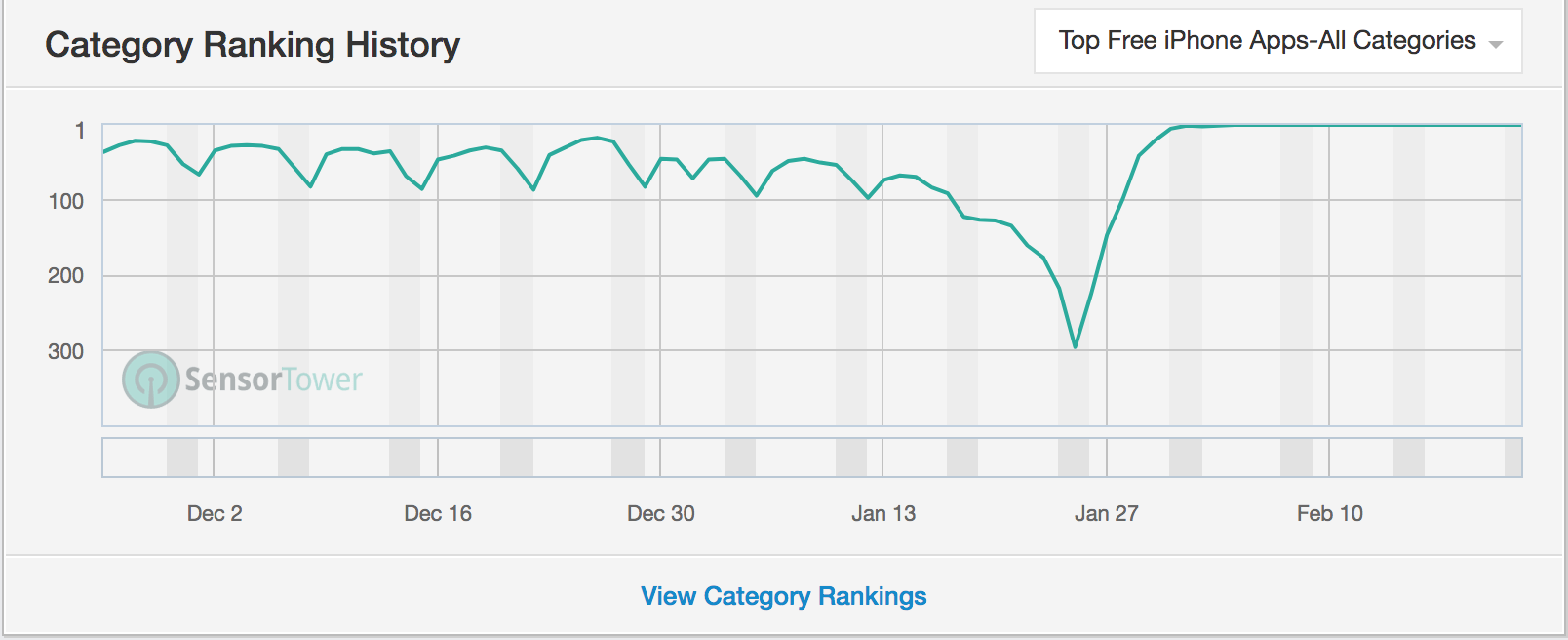
Dingtalk became China’s most-downloaded free iOS app mid the coronavirus outbreak. Data: Sensor Tower
WeChat’s enterprise version WeChat Work, born in 2016, trailed closely behind DingTalk, rising to second place among free iOS apps in the same period. In December, WeChat Work announced it had logged more than 2.5 million enterprises and some 60 million active users.
Lark, launched only in 2019, pales in comparison to its two predecessors, hovering around the 300th mark in early February. Nonetheless, Lark appears to be making a big user acquisition push recently by placing ads on its sibling Douyin, TikTok’s China version. Douyin has emerged as a marketing darling as advertisers rush to embrace vertical, short videos, and Lark can certainly benefit from exposure on the red-hot app. WeChat, despite its colossal one-billion monthly user base, has remained restrained in ad monetization.
The question is whether the sudden boom will develop into a sustainable growth trend for these apps. System crashes on DingTalk and WeChat Work due to user influx at the start of the remote working regime might suggest that neither had projected such traffic volumes on its growth curve. After all, most businesses are expected to resume in-person communication when safety conditions are ensured.
Indeed, the work-from-home model has been widely ill-received by employees who are frustrated with intrusive company rules like “keep your webcam on while working from home.” In a more unexpected turn, DingTalk suffered from a backlash after it added tools to host online classes for students. Resentful that the app had spoiled their extended holiday, young users flooded to give DingTalk one-star ratings.
Face mask algorithms
To curb the spread of the virus, local governments in China have mandated people to wear masks in public, posing a potential challenge to the country’s omnipresent facial recognition-powered identity checks. But the technologies necessary to handle the situation is already in place, such as iris scanning.
Travelers whom I spoke to reported they are now able to pass through train station security without taking their masks off — which could sound an alarm to privacy-conscious individuals. But it’s unclear whether the change is due to more advanced forms of biometrics technologies or that the authority had temporarily loosened security on low-risk individuals. People still have to scan their ID cards before getting their biometrics verified and travelers whose identities have been flagged could trigger stricter screening, people familiar with China’s AI industry told me. They added that the latter case is more probable, for it will take time to implement a nationwide infrastructure upgrade.
Digital passes
Local governments have also introduced tools for people to attain digital records of their travel history, which has become some sort of permit to go about their daily life, be it returning to work, their apartment, or even the city they live in.
One example is web-based app Close Contact Detector developed by a state-owned company. Users can obtain a record of their travel history by opting to submit their names, ID numbers and phone numbers. So far the app has drawn more scorn than praise for containing the virus, bringing people to the questions: If the government already has a grip on people’s travel history, why didn’t it react earlier to restrict the free flow of travelers? Why did it only introduce the service a few weeks after the first big outbreak?
All of this could point to the challenge of collecting and consolidating citizen data across departments and regions, despite China’s ongoing efforts to encourage the use of social credits nationwide through the use of real-name registration and big data. The health crisis appears to have accelerated this data-unification process. The pressing question is how the government will utilize these data following the outbreak.
Many of these digital permits are powered by WeChat on the merit of the messenger’s ubiquity and broad-ranging functions in Chinese society. In Shenzhen, where WeChat’s parent Tencent is headquartered, cars can only enter the city after the drivers use WeChat to scan a QR code hung by a drone — for the obvious reason to avoid contact with checkpoint officers — and digitally file their travel history.
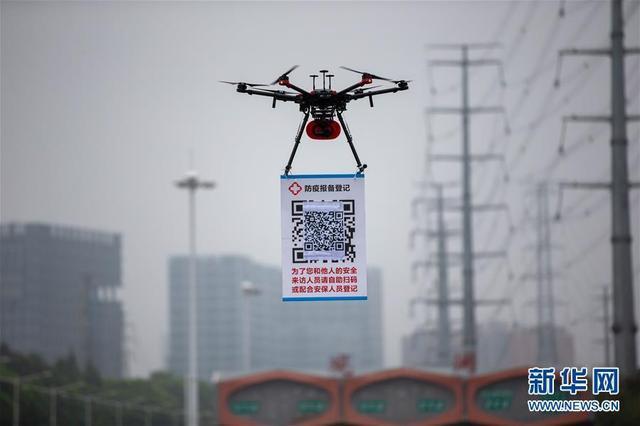
Photo: Xinhua News
Citizen reporting
As the fast-spreading virus fuels rumors, individual citizens are playing an active role in combating misinformation. Dxy.cn (丁香园), an online community targeting medical professionals, responded swiftly with a fact-checking feature dedicated to the coronavirus and a national map tracking the development of the outbreak in real time.
Yikuang, the brainchild of several independent developers and app review site Sspai.com, is one of the first WeChat-based services to map neighborhoods with confirmed cases using official data from local governments.
Young citizens have also joined in. A Shanghai-based high school senior and his peers launched a blog that provides Chinese summaries of coronavirus coverage from news organizations around the world.
Dining and entertainment
The nationwide lockdown is almost guaranteed a boon to online entertainment. The short video sector recorded 569 million daily active users in the post-holiday period, far exceeding 492 million on a regular daily basis, shows QuestMobile. Video streaming sites are gathering musicians to virtually perform and movies are premiering online as the virus forces live venues and cinemas to shut.
Many Chinese cities have gone as far as to ban eating in restaurants during the epidemic, putting the burden on food and grocery delivery services. To ensure safety, delivery companies have devised ways to avoid human interaction, such as Meituan Dianping’s “contactless” solution, which is in effect a self-served cabinet to temporarily store food orders awaiting customer pickup.
https://techcrunch.com/2020/02/23/china-roundup-tech-companies-coronavirus/
#HTE
Financial services startups raised less money in 2019 than they did in 2018 as VC firms looked to back late stage firms and focused on developing markets, a new report has revealed.
According to research firm CB Insights’ annual report published this week, fintech startups across the world raised $33.9 billion* in total last year across 1,912 deals*, down from $40.8 billion they picked up by participating in 2,049 deals the year before.
It’s a comprehensive report, which we recommend you read in full here (your email is required to access it), but below are some of the key takeaways.
- Early stage startups struggled to attract money: Per the report, financing for startups looking to close Seed or Series A dropped to a five-year low in 2019. On the flip side, money pouring into Series B or beyond startups was at record five-year high.

Early-stage deals dropped to a 12-quarter low as deal share globally shifts to mid- and late-stages (CB Insights)
- Emerging and frontier markets were at the centre stage of the most of the action: South America, Africa, Australia, and Southeast Asia all topped their annual highs last year.
- Asia outpaced Europe in the second half of last year on both number of deals and bulk of capital raised. In Q3, European startups raised $1.6 billion through 95 deals, compared to $1.8 billion amassed by Asian startups across 157 deals. In Q4, a similar story was at play: European startups participated in 100 rounds to raise $1.2 billion, compared to $2.14 billion* raised by Asian startups across 125 deals*.
- Emergence of 24 new fintech unicorns in 2019: 8 fintech startups including Next Insurance, Bight Health, Flywire, High Radius, Ripple, and Figure attained the unicorn status in Q4 2019, and 16 others made it to the list throughout the rest of the last year.
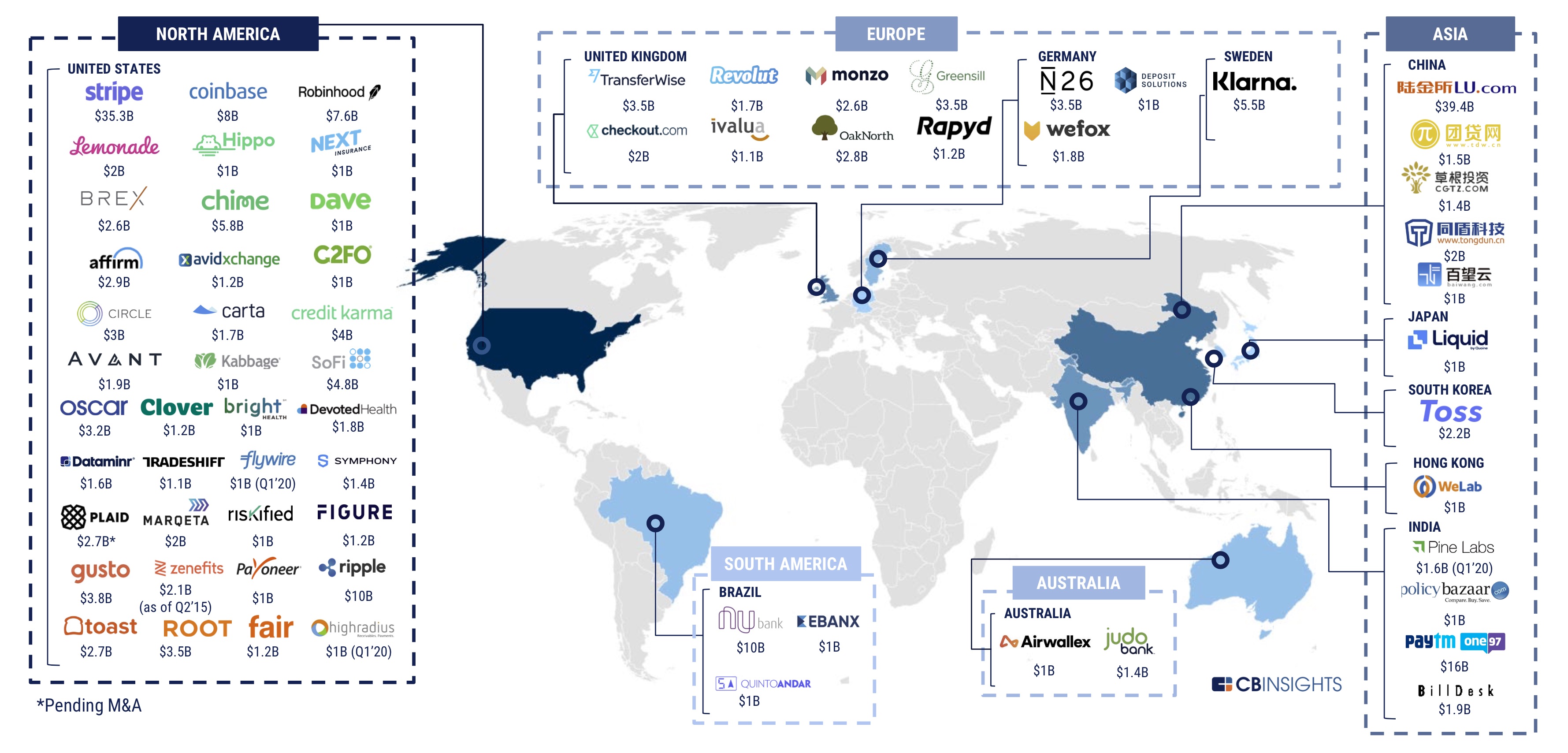
The fintech market globally today has 67 unicorns as of earlier this month (CB Insights)
- Insurtech sector, or startups such as Lemonade, Hippo, Next, Wefox, Bright Health that are offering insurance services, got a major boost last year. They raised 6.2 billion last year, up from $3.2 billion in 2018.
- Startups building solutions such as invoicing and taxing services and payroll and payments solutions for small and medium businesses also received the nod of VCs. In the U.S. alone, where more than 140 startups are operating in the space, raised $4 billion. In many more markets, such startups are beginning to emerge. In India, for instance Open and NiYo are building neo-banks for small businesses and they both raised money last year.
- Nearly 50% of all funding to fintech startups was concentrated in 83-mega rounds (those of size $100 million or above.): According to the research firm, 2019 was a record year for such rounds across the globe, except in Europe.
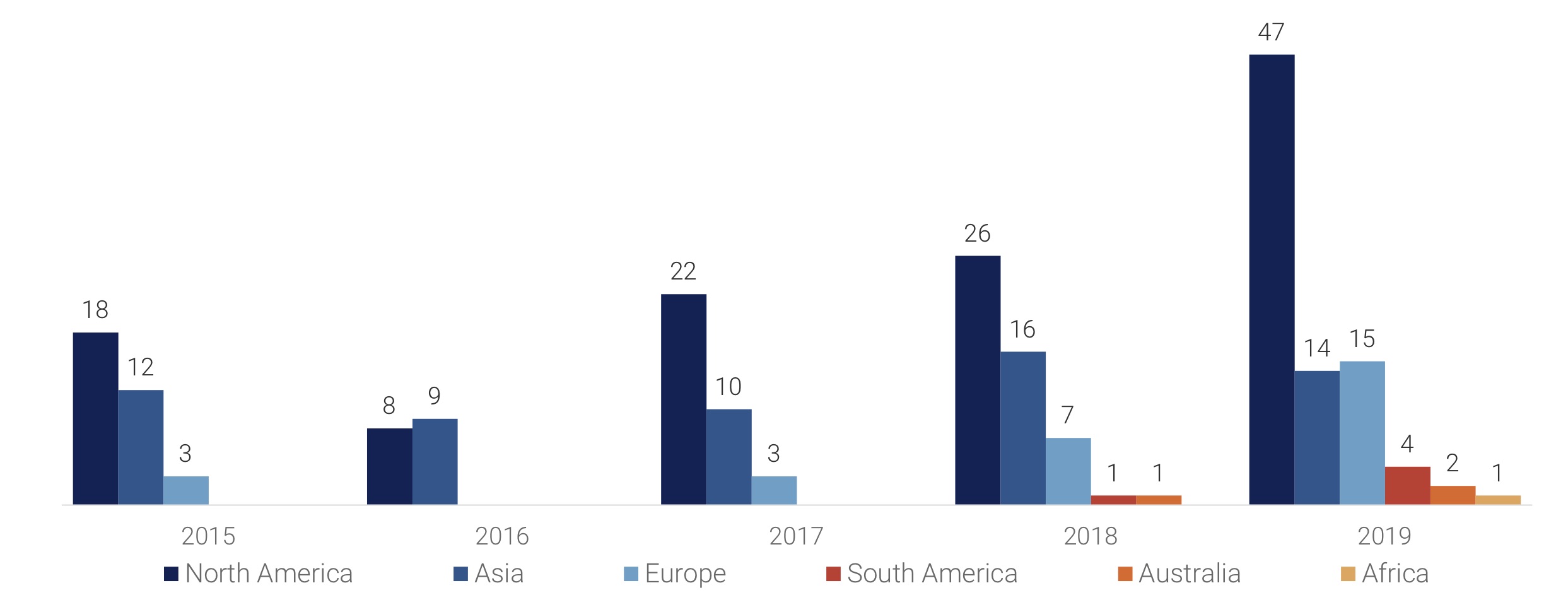
2019 saw 83 mega-rounds totaling $17.2B, a record year in every market except Europe
- Funding of Germany-based startups reached an annual high: 65 deals in 2019 resulted in $1.79 billion raise, compared to 56 deals and raise of $757 million in 2018, and 66 deals and $622 million raise in 2017.
- Financial startups in Southeast Asia (SEA) raised $993 million across 124 rounds in 2019 in what was their best year.
*CB Insights report includes a $666 million financing round of Paytm . It was incorrectly reported by some news outlets and the $666 million raise was part of the $1 billion round the Indian startup had revealed weeks prior. We have adjusted the data accordingly.
https://techcrunch.com/2020/02/22/fintech-startups-raised-34b-in-2019/
#HTE
The coronavirus outbreak could result in at least a 3.3% drop — and as high as a 9% dip — in the volume of PCs that will ship globally this year, research firm Canalys reported Thursday evening in its revised projections to clients.
PC shipments will be down between 10.1% to 20.6% in Q1 2020, the firm estimated. The impact will remain visible in Q2, when the shipments are expected to drop between 8.9% (best case scenario, per Canalys) and 23.4% (worst case scenario), it said.
In the best case scenario, the outbreak would mean 382 million units will ship in 2020, down 3.4% from 396 million last year.
The worst case makes a deeper dent, stating that about 362 million units will ship this year, down 8.5% from last year.
“In the best-case scenario, production levels are expected to revert to full capacity by April 2020, hence the biggest hit will be to sell-in shipments in the first two quarters, with the market recovering in Q3 and Q4,” the firm said.
“Thus, worldwide PC market shipments are expected to decline 3.4% year on year in 2020, with Q1 2020 down by 10% and Q2 2020 by 9%. PC market supply will normalize by Q3 2020. On a yearly basis, Canalys expects the worldwide PC market will slowly begin its recovery starting in 2021.”
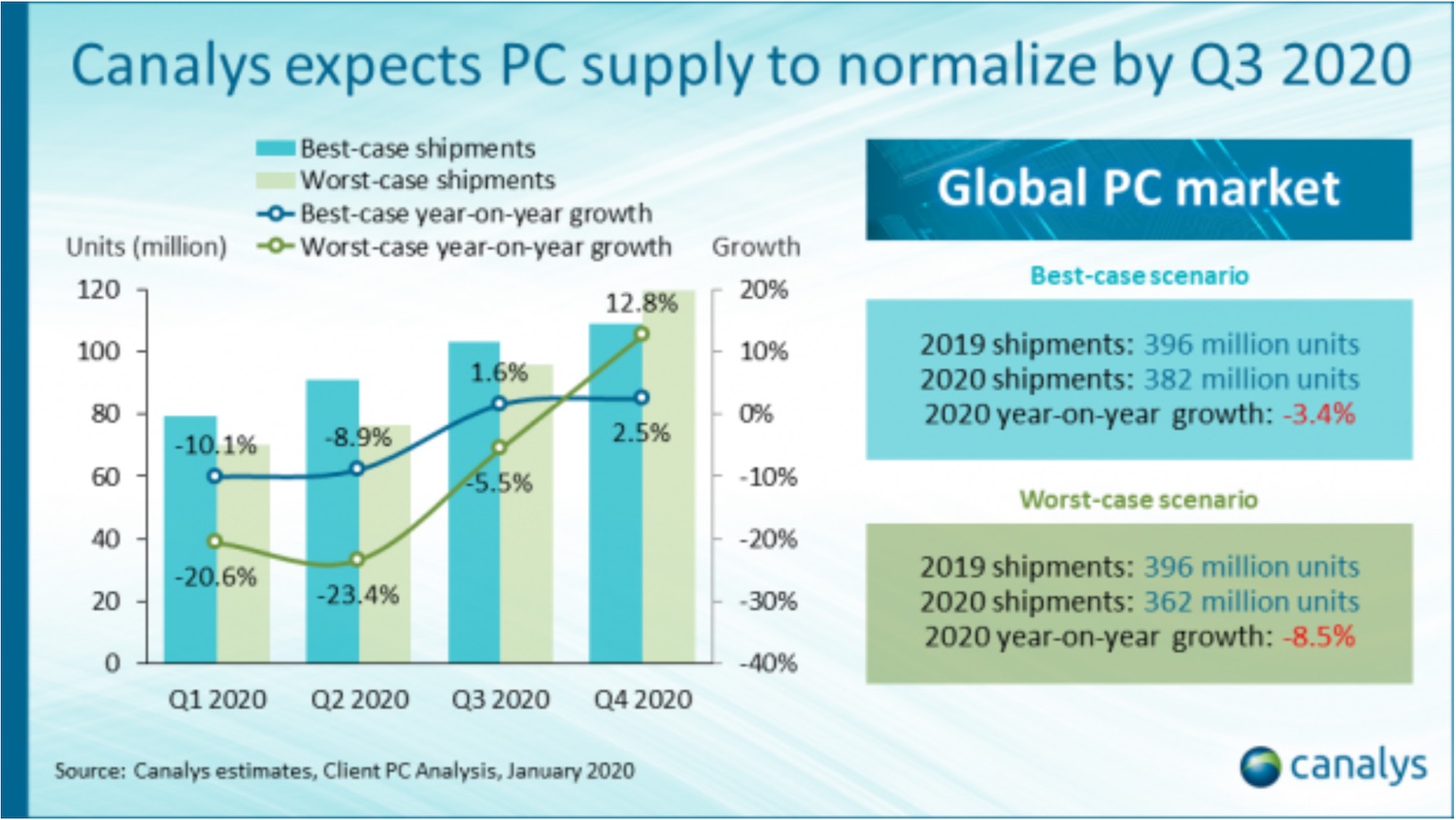
The worst case scenario assumes that production levels will not return to their full capacity by June 2020. “Under the assumptions of this scenario, production and demand levels in China will take even longer to recover and Q2 will suffer a decline on a par with Q1 as a consequence. It will be as late as Q4 2020 until we see a market recovery.”
In either of the scenarios, China, one of the world’s largest PC markets, will be most impacted. In worst case scenarios, “the Chinese market will suffer heavily in 2020 under this scenario, with a 12% year-on-year decline over 2019, and subsequent stabilization taking even longer, with 2021 forecast shipments lagging 6 million behind the best-case scenario. The expected CAGR between 2021 and 2024 in China is 6.3%,” Canalys.
China, the global hub for production and supply chain, moved to contain the impact of coronavirus by first extending the official Lunar New Year holidays, which was followed by stringent travel restrictions to keep citizens safe. “This resulted in a significant drop in offline retail traffic and a dramatic fall in consumer purchases,” Canalys analysts said.
The outbreak has also resulted in supply shortages of components such as PCBs and memory in China and other markets. “Likewise, channel partners have received notifications from key PC vendors over the last two weeks that their PC shipments and replacement parts can be expected to arrive in up to 14 weeks – over three times the usual delivery time – depending on where partners are located,” the firm said.
The outbreak has impacted several more industries, including smartphones, automobiles, television, smart speakers, and video game consoles.
Foxconn, a key manufacturer for Apple, said on Thursday that its 2020 revenue will be impacted by Wuhan coronavirus. The firm said its factories in India, Vietnam, and Mexico are fully loaded and it is planning to expand overseas.
Earlier this month, Apple said it does not expect to meet revenue guidance for March quarter due to constrained iPhone supply and low demand due to the store closures in China.
The US giant is expected to miss its schedule for mass producing a widely rumored affordable iPhone, while inventories for existing models could remain low until April or longer, Nikkei Asian Review reported on Wednesday.
https://techcrunch.com/2020/02/21/pc-shipments-expected-to-drop-this-year-because-of-coronavirus-outbreak/
#HTE
We’ve been dropping into the Australian startup scene increasingly over the years as the ecosystem has been building at an increasingly faster pace, most notably at our own TechCrunch Battlefield Australia in 2017. Further evidence that the scene is growing has come recently in the shape of the Pause Fest conference in Melbourne. This event has gone from strength to strength in recent years and is fast becoming a must-attend for Aussie startups aiming for both national international attention.
I was able to drop in ‘virtually’ to interview a number of those showcased in the Startup Pitch Competition, so here’s a run-down of some of the stand-out companies.
Medinet Australia
Medinet Australia is a health tech startup aiming to make healthcare more convenient and accessible to Australians by allowing doctors to do consultations with patients via an app. Somewhat similar to apps like Babylon Health, Medinet’s telehealth app allows patients to obtain clinical advice from a GP remotely; access prescriptions and have medications delivered; access pathology results; directly email their medical certificate to their employer; and access specialist referrals along with upfront information about specialists such as their fees, waitlist, and patient experience. They’ve raised $3M in Angel financing and are looking for institutional funding in due course. Given Australia’s vast distances, Medinet is well-placed to capitalize on the shift of the population towards much more convenient telehealth apps. (1st Place Winner)
Everty
Everty allows companies to easily manage, monitor and monetize Electric Vehicle charging stations. But this isn’t about infrastructure. Instead, they link up workplaces and accounting systems to the EV charging network, thus making it more like a “Salesforce for EV charging”. It’s available for both commercial and home charging tracking. It’s also raised an Angel round and is poised to raise further funding. (2nd Place Winner)
AI On Spectrum
It’s a sad fact that people with Autism statistically tend to die younger, and unfortunately, the suicide rate is much higher for Autistic people. “Ai on Spectrum” takes an accessible approach in helping autistic kids and their families find supportive environments and feel empowered. The game encourages Autism sufferers to explore their emotional side and arms them with coping strategies when times get tough, applying AI and machine learning in the process to assist the user. (3rd Place Winner)
HiveKeeper
Professional bee-keepers need a fast, reliable, easy-to-use record keeper for their bees and this startup does just that. But it’s also developing a software+sensor technology to give beekeepers more accurate analytics, allowing them to get an early-warning about issues and problems. Their technology could even, in the future, be used to alert for coming bushfires by sensing the changed behavior of the bees. (Hacker Exchange Additional Winner)
Relectrify
Rechargeable batteries for things like cars can be re-used again, but the key to employing them is being able to extend their lives. Relectrify says its battery control software can unlock the full performance from every cell, increasing battery cycle life. It will also reduce storage costs by providing AC output without needing a battery inverter for both new and 2nd-life batteries. Its advanced battery management system combines power and electric monitoring to rapidly the check which are stronger cells and which are weaker making it possible to get as much as 30% more battery life, as well as deploying “2nd life storage”. So far, they have a project with Nissan and American Electric Power and have raised a Series A of $4.5M. (SingularityU Additional Winner)
Gabriel
Sadly, seniors and patients can contract bedsores if left too long. People can even die from bedsores. Furthermore, hospitals can end up in litigation over the issue. What’s needed is a technology that can prevent this, as well as predicting where on a patient’s body might be worst affected. That’s what Gabriel has come up with: using multi-modal technology to prevent and detect both falls and bedsores. Its passive monitoring technology is for the home or use in hospitals and consists of a resistive sheet with sensors connecting to a system which can understand the pressure on a bed. It has FDA approval, is patent-pending and is already working in some Hawaiin hospitals. It’s so far raised $2m in Angel and is now raising money.
Here’s a taste of Pause Fest:
https://techcrunch.com/2020/02/20/heres-our-pick-of-the-top-six-startups-from-pause-fest/
#HTE
Google Cloud today announced that its new Seoul region, its first in Korea, is now open for business. The region, which it first talked about last April, will feature three availability zones and support for virtually all of Google Cloud’s standard service, ranging from Compute Engine to BigQuery, Bigtable and Cloud Spanner.
With this, Google Cloud now has a presence in 16 countries and offers 21 regions with a total of 64 zones. The Seoul region (with the memorable name of asia-northeast3) will complement Google’s other regions in the area, including two in Japan, as well as regions in Hong Kong and Taiwan, but the obvious focus here is on serving Korean companies with low-latency access to its cloud services.
 “As South Korea’s largest gaming company, we’re partnering with Google Cloud for game development, infrastructure management, and to infuse our operations with business intelligence,” said Chang-Whan Sul, the CTO of Netmarble. “Google Cloud’s region in Seoul reinforces its commitment to the region and we welcome the opportunities this initiative offers our business.”
“As South Korea’s largest gaming company, we’re partnering with Google Cloud for game development, infrastructure management, and to infuse our operations with business intelligence,” said Chang-Whan Sul, the CTO of Netmarble. “Google Cloud’s region in Seoul reinforces its commitment to the region and we welcome the opportunities this initiative offers our business.”
Over the course of this year, Google Cloud also plans to open more zones and regions in Salt Lake City, Las Vegas and Jakarta, Indonesia.
https://techcrunch.com/2020/02/19/google-cloud-opens-its-seoul-region/